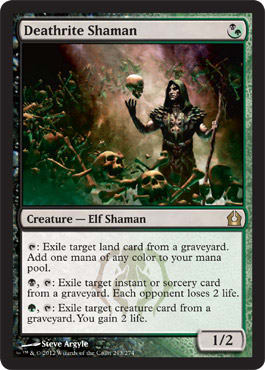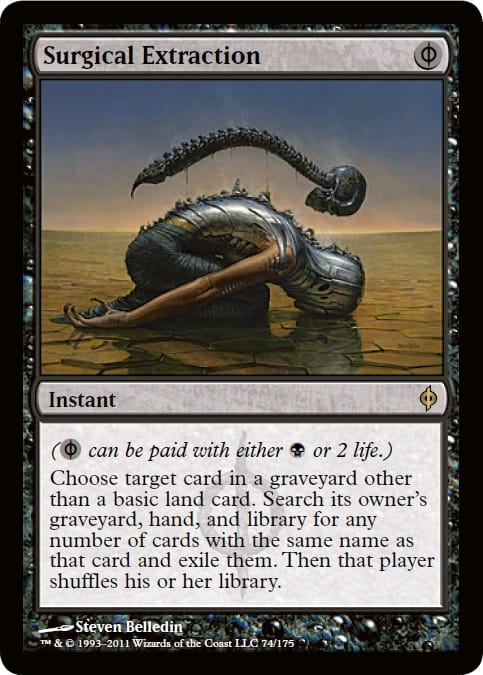Legacy is a format that is slow to adapt. This is not only because of the monetary cost associated with changing decks in a format as expensive as Legacy, but also because there are just not a lot of major Legacy events to encourage people to innovate.
A little over 10 months ago Legacy experienced a bit of a shake up that was long overdue:

In my opinion this change in April of last year was a good one. The ![]()
![]() Miracles deck, that was powered by Sensei's Divining Top, was far and away the best deck in the Legacy format. If your sole goal was winning at an event you needed to be sleeving up your Tundras and your Counterbalances.
Miracles deck, that was powered by Sensei's Divining Top, was far and away the best deck in the Legacy format. If your sole goal was winning at an event you needed to be sleeving up your Tundras and your Counterbalances.
Knocking down the power level of this prison deck left a space to be filled though. A new best deck was eventually going to be found. Over the course of the last 10 months a new deck has solidly cemented itself as the best deck in Legacy: Grixis Delver.
For those who are unfamiliar with this archetype, let's take a peek at the decklist that won the most recent Starcity Games Legacy open:
Grixis Delver -- Legacy | Drake Sasser
- Creatures (15)
- 2 Gurmag Angler
- 2 True-Name Nemesis
- 3 Young Pyromancer
- 4 Deathrite Shaman
- 4 Delver of Secrets
- Instants (18)
- 2 Spell Pierce
- 4 Brainstorm
- 4 Daze
- 4 Force of Will
- 4 Lightning Bolt
- Sorceries (9)
- 1 Forked Bolt
- 4 Gitaxian Probe
- 4 Ponder
- Lands (18)
- 1 Tropical Island
- 2 Volcanic Island
- 3 Underground Sea
- 4 Flooded Strand
- 4 Scalding Tarn
- 4 Wasteland
- Sideboard (15)
- 1 Abrade
- 1 Diabolic Edict
- 1 Dismember
- 2 Flusterstorm
- 2 Price of Progress
- 2 Pyroblast
- 2 Surgical Extraction
- 2 Cabal Therapy
- 2 Marsh Casualties
This deck is a lean, mean, Daze your first spell, flip my Delver, Wasteland your land, and kill you machine.
While this style of aggressive Blue deck is nothing new in Legacy, the tools that this deck now has access to allow it to compete with decks that were once its natural predators. More specifically Deathrite Shaman cuts off a lot of the popular angles of attack for punishing what the Delver deck is trying to accomplish.
For those who are unfamiliar, historically speaking the two best ways to attack decks like Delver are with resource denial strategies and aggressive decks. Because Deathrite Shaman is able to make mana, it allows a deck that tends to skimp on resources to have extra resources for no cost. This makes attacking the deck's mana with Wastelands and or taxing them with Thalia, Guardian of Thraben far less effective. Because Deathrite Shaman is able to gain health, it also helps keep us afloat against aggressive decks while we answer their threats and kill them.
This is the reason Deathrite Shaman is such a powerful card. Not because any single one of its effects is overbearing, but the sum of its parts really put it over the top. Deathrite Shaman takes fast acceleration, something traditionally reserved for Green, and allows decks that are base Black to have access to it. This effectively removes all incentive for fair decks in Legacy to play a color that already had very little going for it.
Because Deathrite Shaman is not only acceleration, but also mana fixing, it allows the greed with which players select the spells they are playing and crank it up to 11. When you remove the inconsistency that is normally associated with playing many colors in Magic, you end up with most decks adapting the same core of cards that are all the most powerful in the format. This isn't specific to Grixis Delver, but to the fair decks in the format as a whole.
Looking at Some Data
In my own experience playing Legacy a good deal in the last year Grixis Delver has felt head and shoulders above the rest of the field for a while now. My personal experience with the deck is not the only thing you should look at though. While we should be aware that all Magic data comes with some bias, we do have a number of data points to look at that all seem to indicate Grixis Delver far out performs many decks in Legacy.
I would like to start with what is possibly the best, and least biased, Magic data we have ever had access to. Last year Eternal Central published every one of the 711 deck lists that were played in their year Legacy Champs event. Having this full data allows us to look at the starting representation each deck had in the event and compare to how many top finishes each of these decks had.
While there are a lot of points of data we can pick out from this data the important one I would like to highlight is with regards to Grixis Delver. Specifically the Grixis Delver, label Delver 4c in their data, had 55 players out of 711 playing it. This is approximately 7.7% of the starting field playing the "best" deck.
711 players means the players in this event played 11 rounds of swiss. At the end of this swiss there were 63 players with a record of 8-3 or better. If a deck like Grixis Delver was average power level, we would expect its 7.7% of the starting players to convert into a similar number of strong finishes, which would be 5 of the 63 players. It far out performed what an average deck would do though. Grixis Delver ended up being 10 of the 63 top performing players, over doubling the percentage (to 15.9%) it started with in the event in terms of how much it occupied of the top performing decks.
While we do not have complete data from any other large events, we do have some incomplete data to draw from that seems to also imply that Grixis Delver over performs compared to other Legacy decks. Most recently we had a 722 player Legacy open that had 71 players make day two. Of these 71 players 18, or 25%, of them were playing Grixis Delver.
A deck being 25% of the field alone is generally cause for surprise in older formats like Legacy. Remember this isn't Standard where there are only 8~ sets worth of cards that are legal. Legacy spans the entirety of Magic -- 25~ years worth of cards. In my opinion, a single archetype being 25% of the day two field should raise some red flags.
We can then compare this day two amount to both the Top 8 and Top 32 players to see if the deck again exceeded expectations even more. Looking at just the Top 8 we again see Delver double up from where our data started; 4 of the 8 decks in the single elimination rounds were Grixis Delver. Pulling back to look at the Top 32 the numbers are slightly less alarming. Only 11 of the Top 32, or 34%, are Delver.
The Counter Argument or "Keep Deathrite" Side
One of the strongest "pro Deathrite Shaman" sentiments I have heard over and over again is how the card keeps the format "honest" by shutting down degenerate graveyard decks. I always found this an interesting stance to take, mostly because if you look at the sideboard of most Deathrite Shaman decks there is more graveyard hate present. If Deathrite Shaman is enough to check these graveyard decks, why do all of these decks have two or more Surgical Extractions in their sideboard?
The second most common argument I have heard in favor of Deathrite Shaman sticking around is that removing Deathrite Shaman hurts fringe decks like Food Chain and Alluren too much. Unfortunately, I have some bad news for lovers of creature combo decks in Legacy; these decks are pretty bad even with Deathrite Shaman in the format. A big part of why they are so bad is because of the utility Deathrite provides Delver -- combo decks natural predator.
As a lover of creature combo decks myself, I honestly think removing Deathrite Shaman would help these combo decks more than it would hurt them. This is because it would reduce the amount of Delver there is in the field, while also making decks like Maverick and Death and Taxes better which tend to be good creature matchups for creature-based combo decks.
The last argument I have heard many times, and personally my least favorite, is that we should not ban cards from the best decks because Legacy is expensive. It costs people too much money to change decks so losing their deck is a burden to the community. I personally am of the opinion that what cards / decks cost should be a non-factor in what cards are and are not legal. Generating quality game play with a balance and variety of archetypes and strategies should be the goal of the ban list. Not worrying about how much a given deck cost to build.
If I put the shoe on the other foot for a moment, though, I think even if we take the "cost" of banning Deathrite Shaman into effect it is still a fine banning. Much like Miracles is still a competitive deck without Sensei's Divining Top, Grixis Delver is still just a core of good cards without Deathrite Shaman. Sure, they will have to stop splashing a fourth color for cards like Ancient Grudge and probably play another land or less 3-drop, but the archetype as a whole is likely to still be competitive.
Wrapping Up
Regardless of what the data says, at the end of the day Magic is about playing what you enjoy. I know there are a number of people out there who like the current Legacy format as is, but I also know there are a number of people out there, like myself, who would not mind a change.
I remember when the span of competitive fair decks in Legacy were fairly distinct with Shardless BUG, RUG Delver, Miracles, Maverick, Jund, and others I am sure I am forgetting. While decks like Maverick and Jund still exist today they are largely played by people who simply enjoy that style of deck, rather than by those who are looking to be as competitive as possible. By the numbers, the best fair decks in Legacy right now are Grixis Delver and 4-color "pile" decks that are arguably the same core as Grixis Delver with a slightly bigger game plan.
Where do you fall on the pro or against Deathrite Shaman argument? Are you fine with Grixis Delver being a quarter or more of the field at competitive events or do you think Wizards should work to diversify the format a bit more? Let me know in a comment below.
Cheers,
--Jeff Hoogland
























